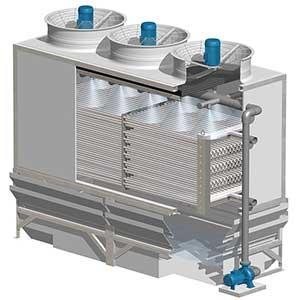Closed Circuit Heat Exchangers
Overview:
Closed Circuit heat exchangers are designed according to customers’ requirements and assure exact compliance with their performance specifications. Our finned systems enhance heat exchange to the tube system and allow low material usage without performance loss. Tooling flexibility allows each system to be adjusted with its tube banks side by side or on top of each other, offers options of meeting extreme customer demands. Our many official approvals and certifications allow us to design and manufacture closed circuit coolers for many and various applications.
Process:
Principle of closed circuit heat exchangers are fan directly coupled to the motor, during operations takes away the heat by induced draft mechanism. Air is drawn from the lower air intake area & is induced to travel through the fill media thus taking away the latent heat from the water passing through the fill media. Portion of water evaporated, removes the heat from the remaining water. The warm moist air is drawn through the fan deck is discharged to the atmosphere. Cold water, collected at the collection sump, is re-circulated to the source. The distinguishing features of our product are compact design Honey comb type PVC fills, with varying flute sizes, to provide maximum contact surface area and heat transfer surface per unit volume.
Image:

Benefits:
- Significantly higher heat transfer coefficients than for plain or low finned tubes
- Heat exchangers with a more compact and lightweight design
- Dramatically reduced fill levels (e.g., refrigerant volumes)
- Ultimate efficiency with minimal temperature differences Precise thermal design with Thermals
Advantages:
- Compact tubular heat exchanger
- Long running times due to turbulent flow
- Very low maintenance costs, minimum spares requirement
- Higher heat transfer coefficient (2-3 times) results in reduction in heat exchanger area up to 50%
- Fouling is minimised due to turbulence created by eddies at the periphery or tube wall
- High response to CIP
- Wide choice of MOC
- Uniform thermal processing
- More flexibility in annular space sizing
Applications:
- Motors, generators
- Nuclear, coal-fired, gas-fired, hydroelectric, and wind power plants
- Series drive systems
- Facilities for operation under extreme and special operating conditions,
- Communication Cabinet
- Electric control cabinet
- Charging stations

